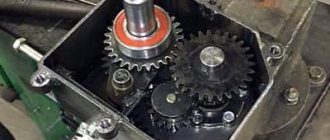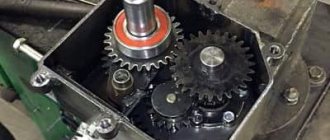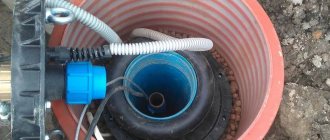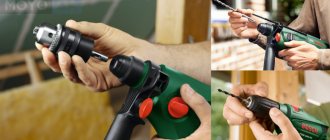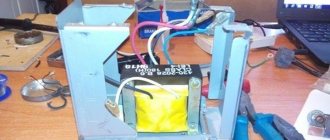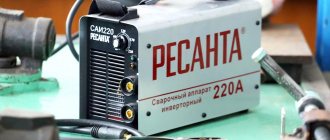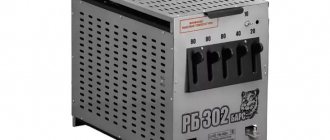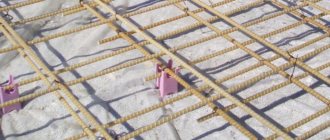The main products produced by JSC KO-Neva are
walk-behind tractorsAndmotor cultivators. These products are manufactured under the brand name “Mototekhnika NEVA”. The products are designed to perform a wide range of agrotechnical and economic operations (ploughing, cultivation, weeding, hilling, planting potatoes, digging up root crops, watering, cleaning the territory, transporting goods). One of the key mechanisms of motor vehicles that ensures their reliability and operational efficiency is the gearbox. You can buy a gearbox for the NEVA walk-behind tractor, as well as a walk-behind tractor, cultivator and attachments in our stores sales representatives, as well as intrade and exhibition complex in St. Petersburg. The price of the product may vary depending on the region of sale. You can install the transmission on the equipment yourself, or by contacting service center.
- Worm gear
- Chain reducer
- Gear reducer
- Gear-chain reducer
How does a walk-behind tractor gearbox work?
A gearbox, often called a converter, is a mechanism that processes the torque of the motor and transmits it to the power take-off shaft of the walk-behind tractor. This happens with the help of a set of gears located in a durable metal casing. The gearbox and the quality of its parts affect the service life of the unit for agricultural work. Therefore, when buying a walk-behind tractor in a store, you should pay great attention to its components, including the gearbox design.
The gearbox can be collapsible or non-dismountable. The latest models are installed on budget-type walk-behind tractors. The parts in them are cheap and cannot be repaired. In case of malfunctions, the gearbox must be replaced. During normal operation, their service life is measured in 1-2 seasons. On expensive equipment, the engine is equipped with a converter of a collapsible design. It serves well for several seasons. If individual parts break down, the failed part is simply replaced.
A converter of any type may include:
- housing (collapsible or not);
- gears and shafts;
- stars;
- belts or chains;
- bearings.
With the help of the listed parts, movements are transmitted from the motor to the mounted implements. The chain is put on the sprockets, the belt is put on the pulleys. The simplest mechanisms are equipped with a belt drive. They are also considered the weakest and most unreliable. When the torque is high, the belts slip and fly off the pulleys. But this design has a beneficial effect on the motor shaft. Belt slippage can be avoided by replacing them with toothed ones. With this replacement, the pulleys also need to be replaced.
Design of the Neva MB-2 gearbox, drawings and description.
The gearbox is designed to transmit torque from the engine (via a V-belt drive) to the wheels of the walk-behind tractor, change the gear ratio (travel speed) and change the direction of movement of the walk-behind tractor (only for the MB-2 walk-behind tractor). Gearbox of the MB-2 walk-behind tractor assembled Fig. 1
Gearbox of the MB-2 walk-behind tractor.
Rice. 1. Gearbox of the MB-2 walk-behind tractor: 1 — drain screw; 2 — bearing 180306; 3 - cuff; 4 — right axle shaft; 5 — axle cover. 6 — sprocket (right axle shaft); 7 - spring; 8 — chain (49 links); 9 — hole for monitoring oil levels; 10 - bushing; 11 — block shaft sprocket; 12 — right half of the body; 13 — bushing; 14 — block sprocket sprocket; 15 — intermediate shaft sprocket; 16 — bushing; 17 — intermediate shaft; 18 — bushing; 19 — input shaft; 20 — filler plug: 21 — shift shaft; 22 — shift fork; 23 — bearing 204; 24 — gear wheel; 25 - cuff; 26 — bushing; 21 — gear wheel; 2S — sprocket block; 29 — bushing; 30 — gear wheel; 31 — gear wheel; 32 — block shaft; 33 - bushing; 34 — left half of the body; 35 — axle separation fork; 36 — clutch of axle shafts; 37 — left axle shaft; 38 — cuff; 39 — bearing 180306; 40 - gasket; 41 — lever; 42 — spring, 43 — screw; 44 - board. Kinematic diagram of the gearbox.
Detailed design of the MB-2 gearbox Fig2
Rice.
2. MB-2 gear housing: 1 - screw; 2 - gasket; 3 - plug; 4 - pin, 5 - board; 6 — washer; 7 - M6 bolt: 8 - gear selector spring; 9 — M6x34 screw; 10 — M6 nut; 11 - gear shift lever; 12 — ball handle; 13 — bolt MB; 14 - cover; 15 — gasket; 16 — M6 bolt; 17 - plate; 18 — spring washer; 19 — washer A8; 20 — ring ST41-29.5-4; 21 — axle cover; 22 - gasket; 23 — left half of the body; 24 - gasket; 25 — right half of the body; 26 - washer. Rice. 3. MB-2 gearbox, internal structure.
Rice. 3. MB-2 gearbox, internal structure: 1 - block shaft; 2 — bushing, 3 — sprocket block; 4 — chain (25 links); 5 - connecting link; 6 — washer; 7 - bushing; 8 — asterisk; 9 — washer; 10 — intermediate shaft; 11 — input shaft, 12 — gear shift shaft; 13, 14 — gear wheels; 15 — gear shift fork; 16 — bearing 204; 17 - cuff; 18 — spring; 19 — gear shift lever; 20 — sealing ring; 21 — washer; 22 - axis; 23 - spring; 24 — axle separation fork; 25 — bracket; 26 — M6x10 screw; 27 — washer; 28 — axle axle release cable; 29 — cuff; 30 — bearing 180306; 31 — thrust axis; 32 — left axle shaft; 33 — cotter pin 2×14; 34 — clutch of axle shafts; 35 — bushing; 36 — connecting link of the chain; 37 — chain (49 links); 38 — right axle shaft.
Note. In the gearboxes of early-release walk-behind tractors, instead of bushings, pos. 2, 7, 35 bearings were installed: pos. 2 — bearing 300, pos. 7 — bearing 202, pos. 35 — bearing 304 GOST 833-75.
The gear lever, which changes the position of the gear wheels 14 and 13 in constant mesh on the input 11 and intermediate 10 shafts, can be installed in five fixed positions: 1-1 forward gear (low); 3 — II gear (highest) forward; 5 — reverse; 2 and 4 are neutral.
The torque on the output axle shafts 38, 32 is transmitted through kinematic chains:
1st gear - input shaft 11, constantly meshed pair of gears 14 and 13, sprocket 8, chain 4, block sprocket 3, constantly meshed pair of gears of block 3 and block shaft 1, block shaft sprockets 1, double chain, double right axle shaft sprocket 38, clutch 34, left axle shaft 32;
2nd gear - input shaft, gears 14 and 13, engagement of wheel 13 with gear of block shaft 1, double chain, double sprocket of right axle shaft 38, clutch 34, left axle shaft 32.
Reverse gear - input shaft, gears 14 and 13, gear block sprocket 3, a pair of gear wheels block sprocket 3 and block 1 and then similarly to 1st and 2nd gears to the right and left axle shafts of the walk-behind tractor.
When you press the control lever for disengaging the axle shafts of the walk-behind tractor, the axle disengagement fork 24 disengages the spline clutch 34 from engagement with the right axle shaft of the gearbox. At the same time, the drive from the engine remains connected to the right axle shaft, allowing you to easily change the direction of movement of the walk-behind tractor up to a turn.
What types of gearboxes are there for a walk-behind tractor?
Gearboxes are divided into types:
- angular;
- downward;
- gear;
- worm;
- chain;
- combined.
All of them find their application on walk-behind tractors of various types.
Angular
The angular gearbox for the walk-behind tractor ensures the coupling of the engine with the transmission and attachment mechanism. Another device is also used, if modified. The corner device consists of the following parts:
- flange;
- flange mounting;
- bearing;
- frame;
- pulley;
- belt;
- steel washer;
- pulley fastening;
- key;
- rotor shaft.
You can make this device yourself. Before work, it is necessary to take into account the conditions in which he will work. These are radial and axial loads at the ends of the shafts. The load depends on the type of lubricants and temperature. It is best to choose a factory-made case. Bearings of the required size are selected for the shaft.
Downward
A reduction gearbox for a walk-behind tractor, either self-made or industrially manufactured, is designed to increase the power of an agricultural unit. This may be necessary when operating the walk-behind tractor on sandy soil, when the wheels begin to slip. It is used on gasoline and diesel vehicles equipped with an air cooling system.
You can reduce the number of revolutions and increase the power of the drive mechanism using reduction gearboxes, which are sometimes called creepers for a walk-behind tractor. They are considered the most reliable for operating a diesel or gasoline air-cooled walk-behind tractor. When the unit is operating, the number of revolutions decreases. This allows you to use the walk-behind tractor for particularly difficult work, for example, plowing heavy soil or harvesting potatoes using a potato digger.
Gear
A gear converter with a differential is used in heavy-duty walk-behind tractors. It is well suited to engines with a vertical crankshaft. The gearbox produces little noise during operation and has high performance. It is capable of functioning in straight and angular patterns. Gears are used both bevel and cylindrical. The device requires the constant presence of oil in the crankcase, but this feature is compensated by its high power.
On heavy units, the gear converter is often equipped with a gearbox. This transmission allows the walk-behind tractor to move in reverse. Reverse occurs during reverse rotation of the gears in the housing. This is achieved by changing the position of the lever outside the housing.
Gear reducer is the best choice for heavy agricultural machinery. An engine equipped with this mechanism runs longer than with a worm version.
Worm
Worm gearboxes are widely used in mini-tractors and walk-behind tractors. This model has gained popularity due to its long period of trouble-free operation and high reliability. The worm-type device has a reverse, allowing the unit to move in reverse. A distinctive feature of this converter is the presence of a special screw and worm wheel. The thread profile on the parts is trapezoidal. They are made from high-strength materials.
The screw can have a four-start thread or a two-start thread. It matches the thread on the gear. The teeth on high-quality parts are made of anti-friction steel. The efficiency of the device is high. Its advantages:
- the gearbox allows you to extend the service life of the engine;
- creates little noise during operation;
- The device consists of only 2 parts;
- has a large gear ratio;
- has a smooth ride;
- high self-braking effect.
All positive qualities appear with precise assembly and adjustment of the mechanism.
Chain
A chain device must have a chain in its design. Sometimes it occurs not just one, but in several pieces. The gear chain is put on the sprockets and ensures their rotation. The device is easy to use, has a reverse function and a high degree of reliability. The operating principle is similar to a belt mechanism. Changing the gear ratio is easy by changing the sprocket sizes. They work like a bicycle, but in reverse: the small one is the driving sprocket, and the large one is the driven sprocket.
Reliability of operation is ensured by the quality of the metal of the sprockets and the strength of the chain. When making your own gearbox, you should use motorcycle sprockets; they are much stronger than bicycle sprockets. The design of the product is simple and reliable, it has a reverse function. The chain requires constant lubrication and tightening. Its rupture is a common cause of gearbox failure. To repair, you need to change the chain.
Combined
The combined gearbox combines gear and worm, worm and cylindrical gears. It can be single-stage or multi-stage. The single-stage mechanism has a gear ratio of up to 7. The body is made of cast iron or welded aluminum. Two-stage devices have a gear ratio of up to 40, three-stage - up to 150.
All of them are designed to change the speed of rotation of the engine shafts and the power take-off shaft. All types of gears are placed in a single housing. The combined mechanism is the most practical. Despite its small size, it has high quality and low cost.
Chain
pros
- Low price.
- A simple design that can be easily repaired at home.
Minuses
- The rotation speed of the lower shaft is excessive, it ranges from 140 rpm. Excessive speed leads to the fact that the gearbox crushes the soil too much, making it dense and unsuitable for planting.
- Due to heavy load, the chain stretches over time.
Creeper
The traction of the wheels of a tillage machine with the soil can be enhanced if you use lugs or a creeper for a walk-behind tractor. The creeper is one of the mounted devices. It makes it possible to reduce the speed of the agricultural unit and increase traction force along with torque. An analogue of a gearbox operates using a chain and sprockets on the shafts. If desired, this device can be made by hand. Parts are used from other equipment.
Each considered converter has its own disadvantages. To reduce their number to a minimum, you should try to make the device yourself. A homemade item can be of higher quality and easier to use than a purchased item.
Motoblock Oka - operating instructions
When purchasing any Oka model, the first thing you need to do is read the operating instructions for the motorized device, which contains the following sections:
- The design of the unit (as well as the design of its components: gearbox, carburetor, etc.).
- Assembling the Oka walk-behind tractor, according to descriptions and diagrams.
- Technical characteristics of the selected model.
- Instructions for starting the engine for the first time (Lifan, Honda or any other).
- The procedure for proper running-in of the power plant.
- Maintenance.
- Troubleshooting the Oka walk-behind tractor.
How to make a gearbox for a walk-behind tractor with your own hands
A homemade gearbox for a walk-behind tractor requires preparation of tools for manufacturing. For fruitful work you will need:
- screwdrivers of different sizes;
- hacksaw for metal;
- pliers;
- bench vice;
- welding machine;
- hammers of different weights;
- rubber for gaskets;
- drill with drills.
Some other tools may be required as you work. From the materials you need to prepare shafts and bearings, sprockets and chains, belts and gears. You can use a caliper to measure parts. Before work you need to complete the simplest drawings.
Preparation
So, the tools and sketches are ready, you need to prepare the material for welding the body or take a ready-made one. You can weld from pieces of stainless steel. The prepared gears should fit freely into the finished housing. They can be borrowed from an old chainsaw. The Friendship brand or any other is suitable. The saw must be carefully disassembled and the entire gears along with the shafts removed. They are cleaned and washed, then sized according to the gear ratio.
When calculating the gear ratio, you should take the number of idle revolutions of the engine crankshaft as a basis and add 10% to it.
With any design of the product, distortions between the parts of the driven and driving parts must not be allowed.
Bearings should also not be replaced with bushings. When disassembling an old saw, you need to remember this.
Assembly
When assembling the product, the parts are carefully inserted into place in the body and rotated. The housing must be sealed tightly. This will protect the parts from dust and dirt. Oil seals are installed on the shafts. Lubricant is poured inside the housing. The homemade device is connected in the same way as a standard gearbox. To test it, start the engine and roll it on the ground. The parts need to get used to each other a little.
Basic rules for performing work
Any work on disassembling and assembling the gearbox, as well as its maintenance, must be carried out at a previously prepared workplace with all the necessary tools. The cleanliness of the workplace must be ensured, which will prevent dust, dirt and debris from getting into the mechanism . It is advisable to carry out all work wearing clean work gloves, which will provide both protection of hands from injury and contamination, and protection of gearbox components from unwanted debris and dust.
Carefully monitor the condition of the tool you are using - there should be no noticeable damage, especially cracks . Failure to do so may result in serious injury.
Before disassembling the gearbox, drain the oil from it. After this, you need to thoroughly clean all parts of the device from possible contamination.
After repairing and assembling the gearbox, be sure to fill it with fresh oil before operating it.
How much oil to pour into the walk-behind tractor gearbox
When operating the walk-behind tractor, it is necessary to maintain a constant oil level in the gearbox. If this simple rule is not followed, lubricant residues may boil and jam the parts. Only high-quality oil is poured. Even with constant maintenance of the level, breakdowns occur. During chain transmission, the chain breaks or is pulled out. If traces of oil appear on the outside, this is a sign of leaking seals. Worn parts require replacement with similar ones. It is better to purchase them from a reputable manufacturer.
The gearbox ensures uninterrupted operation of the walk-behind tractor, extends its service life and increases the efficiency of use of the unit. A good helper in this matter is to lubricate its parts. Transmission oil is poured in for lubrication. Its possible brand is ZIC 10W40, Super T-3. The oil level is determined in this way:
- you need to take a wire approximately 70 cm long instead of a probe and bend it into an arc;
- insert into the filling hole until it stops;
- pull the homemade dipstick back;
- the wire should be oiled to a length of about 30 cm.
This level is considered to be the norm. If there is little oil, you need to add it to the norm. In a purchased gearbox, the level must be indicated in the instructions. A Chinese walk-behind tractor can be sold without oil.
